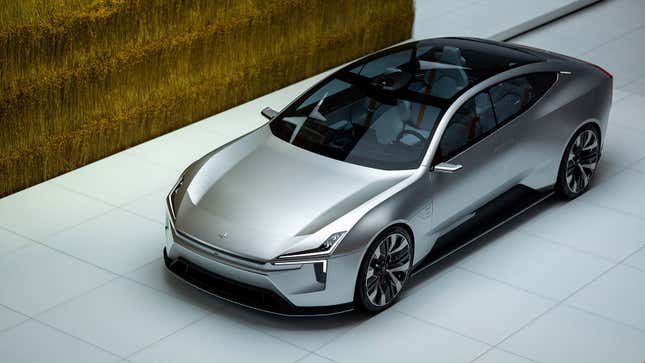Polestar’s Design Is Evolving Away From Its Volvo Roots

When Polestar first started up back in 2005, it was a racing team that would often lend its performance experience to Volvo to make its road cars that little bit more extreme. But then, in 2015, it was acquired by the Swedish company and spun out as its own car brand. It’s had close ties to Volvo ever since, but now the automaker’s head of design says the brand is working to evolve away from its roots.
Polestar Jumps on the SUV Bandwagon With the New 3
In case you missed it:
Maximilian Missoni, the head of design for Polestar, spoke with Jalopnik at a launch event for the new Polestar 3, the company’s first SUV. The new car is set to hit the road later this year, and is built on the same platform as Volvo’s new EX90 SUV, but with its own Polestar flourishes, as Missoni explains:
“It’s on the electric platform that we share with the Volvo cars. But what’s special about this car is that the seats in the third row have been removed. The remaining rows are moved far apart from each other, so you have much [more] leg room in the second row and the seating position is more sporty than in a traditional SUV.
“The whole car has a more sleek silhouette because of that.”
This is what a sleek silhouette looks like, apparently.Photo: Polestar
It’s easy to see what Missoni means here, where the Volvo is much taller and boxier at the rear, the Polestar has an elegant swoop to it. And, when you get up close to each, the Polestar feels like a smaller car from the outside, yet still spacious on the interior.
“It’s a very archetypical SUV with the wheel liners,” Missoni explains. “It has a very upright, tall front and all of these hallmarks that people like about SUVs, that Americans like about SUVs, that I like about SUVs. But it’s kind of transferred into this more efficient electric age by making it lower, by creating these aerodynamic enhancements.”
And this is where Missoni hopes to set his brand apart from its Swedish sibling, with its “distinct Polestar language.”
On the 3, this includes a different front end compared to the EX90 that incorporates the company’s “Smartzone” array of sensors and cameras, as well as a discrete wing that helps direct airflow over the car.

Same, same but different. Photo: Polestar
But there remain callbacks to Polestar’s roots in the Volvo group, such as its dual blade headlamps, which are clearly inspired by Volvo’s own Thor’s Hammer lighting array that will be found on the EX90. But, on the Polestar 3, they are a much simpler, sleeker affair.
“There has been a bit of an evolution,” Missoni explains. “Because the 2 has some of it, the 3 takes it to the next level, and if you then think of Precept that will be the 5, and the 4 in between, all these cars go into a distinct Polestar language.”
But the similarities to Volvo have been a help, not a hindrance, for the brand as it launches in new markets around the world. In places like the US, people are familiar with Volvo and know what the company stands for, so crossover between the two marques, initially, helped set Polestar apart from other new EV brands entering the space.

Polestar Precept: Clearly not a Volvo. Photo: Polestar
As Polestar continues expanding its range and building its customer base around the world, things will change, Missoni told me.
“They will be completely separate,” he says. “Because now we’ve been physically separated in terms of the teams, the location, everything, for a couple of years.
“But products are long cycles. So, but when you look at the Precept that we have shown, I think that is clearly not a Volvo.”


